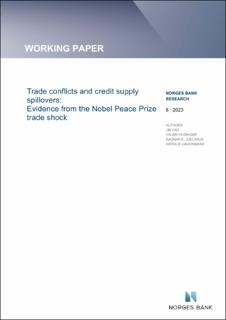| dc.contributor.author | Cao, Jin | |
| dc.contributor.author | Dinger, Valeriya | |
| dc.contributor.author | Juelsrud, Ragnar E. | |
| dc.contributor.author | Liaudinskas, Karolis | |
| dc.date.accessioned | 2023-06-27T08:11:06Z | |
| dc.date.available | 2023-06-27T08:11:06Z | |
| dc.date.issued | 2023 | |
| dc.identifier.isbn | 978-82-8379-283-6 | |
| dc.identifier.issn | 1502-8143 | |
| dc.identifier.uri | https://hdl.handle.net/11250/3073366 | |
| dc.description.abstract | In this paper, we examine how a trade conflict’s impact on the real economy can be amplified by financial intermediaries. After China’s implicit ban on the imports of Norwegian salmon in response to the decision on 2010 Nobel Peace Prize, we find that banks that are highly exposed to the salmon industry cut back lending to non-salmon firms and households by 3-6 percent more than other banks. Furthermore, we find that the reduction in lending was not driven by the erosion of bank capital, but rather by the shift in expectations about the performance of loans to salmon producers, which drove highly exposed banks to increase their loan loss provisions and reduce risk-taking. | en_US |
| dc.language.iso | eng | en_US |
| dc.relation.ispartofseries | Working paper;6/2023 | |
| dc.rights | Attribution-NonCommercial-NoDerivatives 4.0 Internasjonal | * |
| dc.rights.uri | http://creativecommons.org/licenses/by-nc-nd/4.0/deed.no | * |
| dc.subject | trade shock | en_US |
| dc.subject | bank lending channel | en_US |
| dc.subject | expectation shock | en_US |
| dc.subject | JEL: F14 | en_US |
| dc.subject | JEL: G21 | en_US |
| dc.title | Trade conflicts and credit supply spillovers : Evidence from the Nobel Peace Prize trade shock | en_US |
| dc.type | Working paper | en_US |
| dc.description.version | publishedVersion | en_US |
| dc.subject.nsi | VDP::Samfunnsvitenskap: 200::Økonomi: 210::Samfunnsøkonomi: 212 | en_US |
| dc.source.pagenumber | 30 | en_US |

